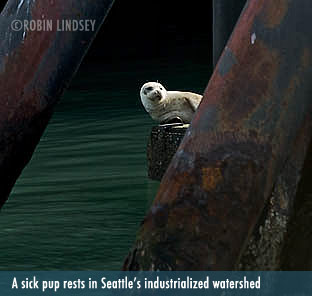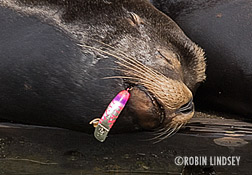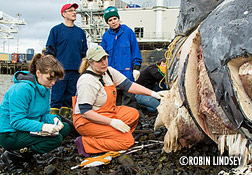TOXIC SEALS: OUR POLLUTED WATERS
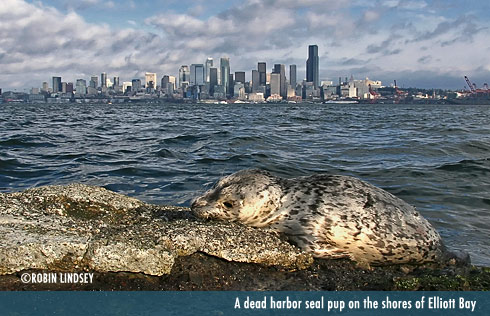 SENTINELS OF THE SOUND
SENTINELS OF THE SOUND
Harbor seals are unfortunate and unwitting barometers for our polluted environment. An ecosystem poisoned by mankind with contaminants, sewage, trash and inorganic marine debris directly impacts their health and that of all living beings in and around the waters of Puget Sound, Elliott Bay and the Duwamish River.
DEADLY TOXINS ARE ABSORBED BY MARINE MAMMALS
Harbor seals in particular are affected by pollution because they do not migrate, but instead, live year-round in our region. Because of this, they are considered a sentinel species, indicating the health of the marine environment. If the seals are sick, our waters are sick.
Seals' thick layers of blubber absorb and retain pollutants from our industrial waterways. In fact, a 2005 study showed the harbor seals of South Puget Sound were 7 times more contaminated than those living in Canada’s Georgia Strait. Biologists use tissue samples from both live and dead seals to monitor the health of the Sound, measuring levels of PCBs, increasing numbers of chemicals used in flame retardants known as PBDEs, pesticides and other highly toxic waste.
While a ban of PCBs has reduced those toxins in recent years, the number of chemicals used in flame retardants (including those known as PBDEs) have greatly increased. Studies show that PBDE concentrations have been doubling every 3.5 years and have even been detected in the high Arctic.
Contaminants are stored in the blubber of marine mammals at the top of the food chain, such as dolphins, seals and orcas. The Southern Resident orcas are among the most contaminated marine mammals in the world. These toxins pass from generation to generation through the milk of mothers to their offspring. Humans, of course, are also at the top of the food chain - and those who consume fish from these toxic waters have high contaminant loads.
In the Main Basin of Puget Sound, seal pups are more highly contaminated with PCBs and PBDEs than other areas of Puget Sound. Sadly, because seal pups are so contaminated, they are considered the ideal subject for these studies.
Exposure to flame retardants causes physical abnormalities (including that of the brain, impairing the development of motor activities and cognition), behavioral changes, impairs reproduction and causes immune disorders in marine mammals.
In recent years, researchers discovered a link between contaminants and compromised immune systems of harbor seals. Weakened seals become vulnerable to parasitic infections, low body weight and numerous viruses, often leading to fatalities. Read the full study of contaminants in Puget Sound here.
Harbor seals and pups haul out on the wooden piers and beaches in the highly industrial and contaminated Duwamish Waterway, a superfund project. They forage for food in the same waters where signs warn that shellfish is unsafe for human consumption due to contaminants. A number of pups in this location were found by Washington Department of Fish and Wildlife and PAWS Wildlife Center, a NOAA resource for harbor seal rehabilitation, to have lungworm infestation, pneumonia and/or a fatal virus.

Harbor seals are unfortunate and unwitting barometers for our polluted environment. An ecosystem poisoned by mankind with contaminants, sewage, trash and inorganic marine debris directly impacts their health and that of all living beings in and around the waters of Puget Sound, Elliott Bay and the Duwamish River.
DEADLY TOXINS ARE ABSORBED BY MARINE MAMMALS
Harbor seals in particular are affected by pollution because they do not migrate, but instead, live year-round in our region. Because of this, they are considered a sentinel species, indicating the health of the marine environment. If the seals are sick, our waters are sick.
Seals' thick layers of blubber absorb and retain pollutants from our industrial waterways. In fact, a 2005 study showed the harbor seals of South Puget Sound were 7 times more contaminated than those living in Canada’s Georgia Strait. Biologists use tissue samples from both live and dead seals to monitor the health of the Sound, measuring levels of PCBs, increasing numbers of chemicals used in flame retardants known as PBDEs, pesticides and other highly toxic waste.
While a ban of PCBs has reduced those toxins in recent years, the number of chemicals used in flame retardants (including those known as PBDEs) have greatly increased. Studies show that PBDE concentrations have been doubling every 3.5 years and have even been detected in the high Arctic.
Contaminants are stored in the blubber of marine mammals at the top of the food chain, such as dolphins, seals and orcas. The Southern Resident orcas are among the most contaminated marine mammals in the world. These toxins pass from generation to generation through the milk of mothers to their offspring. Humans, of course, are also at the top of the food chain - and those who consume fish from these toxic waters have high contaminant loads.
In the Main Basin of Puget Sound, seal pups are more highly contaminated with PCBs and PBDEs than other areas of Puget Sound. Sadly, because seal pups are so contaminated, they are considered the ideal subject for these studies.
Exposure to flame retardants causes physical abnormalities (including that of the brain, impairing the development of motor activities and cognition), behavioral changes, impairs reproduction and causes immune disorders in marine mammals.
In recent years, researchers discovered a link between contaminants and compromised immune systems of harbor seals. Weakened seals become vulnerable to parasitic infections, low body weight and numerous viruses, often leading to fatalities. Read the full study of contaminants in Puget Sound here.
Harbor seals and pups haul out on the wooden piers and beaches in the highly industrial and contaminated Duwamish Waterway, a superfund project. They forage for food in the same waters where signs warn that shellfish is unsafe for human consumption due to contaminants. A number of pups in this location were found by Washington Department of Fish and Wildlife and PAWS Wildlife Center, a NOAA resource for harbor seal rehabilitation, to have lungworm infestation, pneumonia and/or a fatal virus.
STORM RUNOFF POLLUTES THE MARINE ENVIRONMENT
Storm runoff has become a major factor in marine pollution. Chemicals added to lawns, gardens and agricultural fields, human and animal waste, highway oil and gasoline residue all can end up in our waterways. Household chemicals and pharmaceuticals flushed down a drain end up in our waters as well --- and ultimately into our fish, seals and other marine mammals.
Puget Sound now has areas where no marine life can subsist, known as dead zones. Learn more about how dead zones are growing globally. While climate change plays an important part, so does agricultural storm runoff which produces a toxic bloom of algae, which poisons marine life and is having an especially devastating effect on West Coast sea lions.
View the recent Frontline PBS documentary Poisoned Waters which features our troubled Puget Sound.
PLASTICS BREAK DOWN INTO MINUTE PARTICLES AND ENTER THE FOOD CHAIN
Plastic bags and balloons are often mistaken for food. If consumed by marine mammals, it can result in a slow and painful death. Plastic litter does not biodegrade; instead, it photo-degrades - a process where sunlight breaks it down into minute pieces of plastic that enter the food chain. These plastic polymers are a magnet for pcbs and other toxic chemicals. Once ingested they create hormonal imbalances and affect reproductive abilities and brain activity in fish, invertebrates and marine mammals.
Plastic litter from all over the earth ends up in the ocean, gets caught up in ocean currents and has created a giant swirling mass of 7 million tons of toxic debris twice the size of Texas - dubbed the "Great Pacific Garbage Patch." The waters in this immense area contain 6 times more plastic than plankton, a primary food source for fish and marine mammals. This garbage vortex is not the only one in the oceans, just the biggest.
Contaminant-laced plastic is found at all levels of the food chain in our oceans, ultimately affecting humans as well who consume seafood.
Storm runoff has become a major factor in marine pollution. Chemicals added to lawns, gardens and agricultural fields, human and animal waste, highway oil and gasoline residue all can end up in our waterways. Household chemicals and pharmaceuticals flushed down a drain end up in our waters as well --- and ultimately into our fish, seals and other marine mammals.
Puget Sound now has areas where no marine life can subsist, known as dead zones. Learn more about how dead zones are growing globally. While climate change plays an important part, so does agricultural storm runoff which produces a toxic bloom of algae, which poisons marine life and is having an especially devastating effect on West Coast sea lions.
View the recent Frontline PBS documentary Poisoned Waters which features our troubled Puget Sound.
PLASTICS BREAK DOWN INTO MINUTE PARTICLES AND ENTER THE FOOD CHAIN
Plastic bags and balloons are often mistaken for food. If consumed by marine mammals, it can result in a slow and painful death. Plastic litter does not biodegrade; instead, it photo-degrades - a process where sunlight breaks it down into minute pieces of plastic that enter the food chain. These plastic polymers are a magnet for pcbs and other toxic chemicals. Once ingested they create hormonal imbalances and affect reproductive abilities and brain activity in fish, invertebrates and marine mammals.
Plastic litter from all over the earth ends up in the ocean, gets caught up in ocean currents and has created a giant swirling mass of 7 million tons of toxic debris twice the size of Texas - dubbed the "Great Pacific Garbage Patch." The waters in this immense area contain 6 times more plastic than plankton, a primary food source for fish and marine mammals. This garbage vortex is not the only one in the oceans, just the biggest.
Contaminant-laced plastic is found at all levels of the food chain in our oceans, ultimately affecting humans as well who consume seafood.
MARINE DEBRIS & ENTANGLEMENTS
Countless numbers (some say millions) of sea creatures suffer injuries or die each year from marine debris and fishing gear entanglements. Did you know 80% of marine trash originates from land? Learn more.
Countless numbers (some say millions) of sea creatures suffer injuries or die each year from marine debris and fishing gear entanglements. Did you know 80% of marine trash originates from land? Learn more.
SHIP STRIKES
Large whales are especially vulnerable to injury and death from ship strikes as they migrate along the US coastline. Learn more.
Large whales are especially vulnerable to injury and death from ship strikes as they migrate along the US coastline. Learn more.
RELATED LINKS
LINKS ON POLLUTANTS
PUGET SOUND HARBOR SEALS HELP SCIENTIST TRACK POLLUTANTS Seattle Times
PUGET SOUND GEORGIA BASIN ECOSYSTEM INDICATOR REPORT U.S. Environmental Protection Agency
BURNING ISSUE: FLAME RETARDANTS IN HARBOR SEALS
PUGET SOUND GEORGIA BASIN TOXICS IN HARBOR SEALS U.S. Environmental Protection Agency
LINKS ABOUT OUR TOXIC SOUND AND EFFECTS ON MARINE LIFE
BEYOND PUGET SOUND: TEN IDEAS FOR SAVING THE SALISH SEA Seattle Times (May 2009)
FAILING OUR SOUND Seattle Times (June 2008)
THE SOUND OF BROKEN PROMISES Seattle Post-Intelligencer
A RISING TIDE OF CHEMICALS AND POLLUTANTS Seattle Post-Intelligencer
OUR TROUBLED SOUND Seattle Post-Intelligencer
ORCAS SO FULL OF POLLUTANTS, IT'S ENOUGH TO SICKEN THEM Seattle Post-Intelligencer
STORMWATER'S DAMAGE TO PUGET SOUND HUGE, REPORT SAYS Seattle Times
PUGET SOUND IN DECLINING HEALTH USA Today
TROUBLED WATERS: HOOD CANAL'S DEAD ZONE
SCIENTISTS TALLY DAMAGE A DAY AFTER FISH DIE-OFF IN TROUBLED HOOD CANAL Seattle Times
RELATED POLLUTION NEWS
PACIFIC OCEAN "DEAD ZONE" IN NORTHWEST MAY BE IRREVERSIBLE LA TIMES (October 9, 2009)
An oxygen-depleted "dead zone" the size of New Jersey is starving sea life off the coast of Oregon and Washington and might be impossible to reverse.
PLASTICS POLLUTION
BEACHED WHALES KILLED BY INGESTING PLASTIC (Dec 18, 2009)
Seven sperm whales that beached in Italy died from ingesting plastic in the ocean.
GREAT PACIFIC GARBAGE PATCH National Georgraphic Education.
Excellent resource with maps explaining that the Great Pacific Garbage Patch is not the only one - and why.
SOLUTIONS TO PLASTIC POLLUTION IN OUR OCEANS National Resources Defense Council.
THE GREAT PACIFIC GARBAGE PATCH Wikipedia.
A definitive resource for information with many links.
THE GREAT PACIFIC GARBAGE PATCH Good Morning America. Video.
THE WORLD'S LARGEST DUMP: THE GREAT PACIFIC GARBAGE PATCH Discover Magazine.
CAPT. CHARLES MOORE ON THE SEAS OF PLASTIC TED.com.
Compelling video of Charles Moore, founder of the Algalita Marine Research Foundation. He captains the foundation's research vessel, the Alguita, documenting the great expanses of plastic waste that now litter the Pacific.
AGALITA MARINE RESEARCH FOUNDATION
Algalita's current research includes the prevalence and quantification of plastic debris in the North Pacific Sub-tropical Gyre (NPSG), biological impact of plastics on marine life and the human food chain, and the desorption of plastic toxins into the ambient ocean water. This site includes much valuable in-depth technical information on the Great Pacific Garbage Patch which is contained within the North Pacific Gyre ("gyre" is a swirling vortex of currents).
HOW STUFF WORKS: THE GREAT PACIFIC GARBAGE PATCH
PLAGUE OF PLASTIC CHOKES THE SEAS. Los Angeles Times.
LINKS ON POLLUTANTS
PUGET SOUND HARBOR SEALS HELP SCIENTIST TRACK POLLUTANTS Seattle Times
PUGET SOUND GEORGIA BASIN ECOSYSTEM INDICATOR REPORT U.S. Environmental Protection Agency
BURNING ISSUE: FLAME RETARDANTS IN HARBOR SEALS
PUGET SOUND GEORGIA BASIN TOXICS IN HARBOR SEALS U.S. Environmental Protection Agency
LINKS ABOUT OUR TOXIC SOUND AND EFFECTS ON MARINE LIFE
BEYOND PUGET SOUND: TEN IDEAS FOR SAVING THE SALISH SEA Seattle Times (May 2009)
FAILING OUR SOUND Seattle Times (June 2008)
THE SOUND OF BROKEN PROMISES Seattle Post-Intelligencer
A RISING TIDE OF CHEMICALS AND POLLUTANTS Seattle Post-Intelligencer
OUR TROUBLED SOUND Seattle Post-Intelligencer
ORCAS SO FULL OF POLLUTANTS, IT'S ENOUGH TO SICKEN THEM Seattle Post-Intelligencer
STORMWATER'S DAMAGE TO PUGET SOUND HUGE, REPORT SAYS Seattle Times
PUGET SOUND IN DECLINING HEALTH USA Today
TROUBLED WATERS: HOOD CANAL'S DEAD ZONE
SCIENTISTS TALLY DAMAGE A DAY AFTER FISH DIE-OFF IN TROUBLED HOOD CANAL Seattle Times
RELATED POLLUTION NEWS
PACIFIC OCEAN "DEAD ZONE" IN NORTHWEST MAY BE IRREVERSIBLE LA TIMES (October 9, 2009)
An oxygen-depleted "dead zone" the size of New Jersey is starving sea life off the coast of Oregon and Washington and might be impossible to reverse.
PLASTICS POLLUTION
BEACHED WHALES KILLED BY INGESTING PLASTIC (Dec 18, 2009)
Seven sperm whales that beached in Italy died from ingesting plastic in the ocean.
GREAT PACIFIC GARBAGE PATCH National Georgraphic Education.
Excellent resource with maps explaining that the Great Pacific Garbage Patch is not the only one - and why.
SOLUTIONS TO PLASTIC POLLUTION IN OUR OCEANS National Resources Defense Council.
THE GREAT PACIFIC GARBAGE PATCH Wikipedia.
A definitive resource for information with many links.
THE GREAT PACIFIC GARBAGE PATCH Good Morning America. Video.
THE WORLD'S LARGEST DUMP: THE GREAT PACIFIC GARBAGE PATCH Discover Magazine.
CAPT. CHARLES MOORE ON THE SEAS OF PLASTIC TED.com.
Compelling video of Charles Moore, founder of the Algalita Marine Research Foundation. He captains the foundation's research vessel, the Alguita, documenting the great expanses of plastic waste that now litter the Pacific.
AGALITA MARINE RESEARCH FOUNDATION
Algalita's current research includes the prevalence and quantification of plastic debris in the North Pacific Sub-tropical Gyre (NPSG), biological impact of plastics on marine life and the human food chain, and the desorption of plastic toxins into the ambient ocean water. This site includes much valuable in-depth technical information on the Great Pacific Garbage Patch which is contained within the North Pacific Gyre ("gyre" is a swirling vortex of currents).
HOW STUFF WORKS: THE GREAT PACIFIC GARBAGE PATCH
PLAGUE OF PLASTIC CHOKES THE SEAS. Los Angeles Times.
YOU CAN HELP CLEAN UP PUGET SOUND WATERWAYS
Individuals do make a difference. Get involved and please visit the websites of these great organizations:
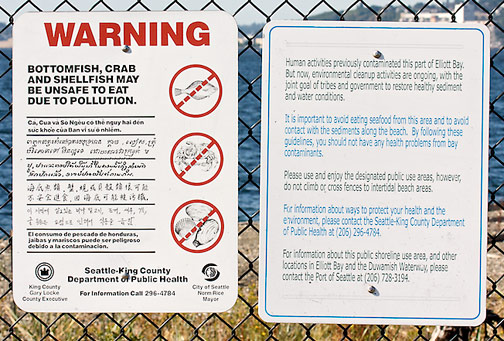 Duwamish Alive Coalition. Collaborates with community, municipalities, non-profits and business within the Duwamish River Watershed to preserve and enhance habitat for people and wildlife.
Duwamish Alive Coalition. Collaborates with community, municipalities, non-profits and business within the Duwamish River Watershed to preserve and enhance habitat for people and wildlife.
Duwamish River Cleanup Coalition. An alliance of community, environmental and small business groups whose mission is to clean up the Duwamish River.
Puget Soundkeeper Alliance. A team of dedicated staff and volunteers whose mission is to stop pollution from entering Puget Sound.
People for Puget Sound. Established to protect and restore the health of Puget Sound land and waters through education and action.
Individuals do make a difference. Get involved and please visit the websites of these great organizations:

Duwamish River Cleanup Coalition. An alliance of community, environmental and small business groups whose mission is to clean up the Duwamish River.
Puget Soundkeeper Alliance. A team of dedicated staff and volunteers whose mission is to stop pollution from entering Puget Sound.
People for Puget Sound. Established to protect and restore the health of Puget Sound land and waters through education and action.
